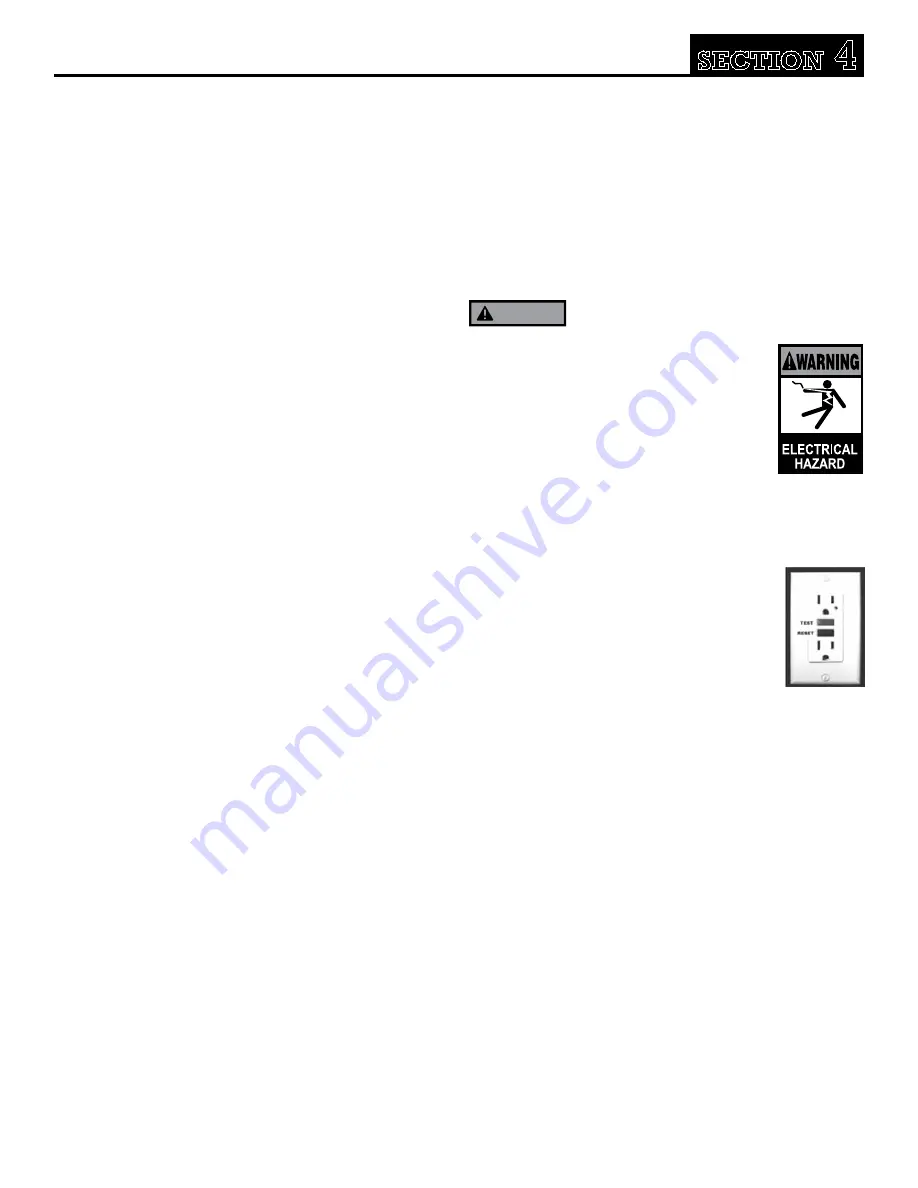
Page 25
Page 25
SECTION
4
Living Quarters, LP and Electrical
with an electrical ground such as water, plumbing or the
earth.
If an imbalance is detected, the GFCI will trip and shut off
power to the outlet. Even with GFCI protection, the electrical
shock will still be felt, but to a lesser degree. It also does
not protect against short circuits or system overloads. Circuit
breakers in the main panel which supply power to the
circuit, will trip if either of these conditions exists. The GFCI
receptacle should be tested initially when the recreational
vehicle is purchased, and at least monthly thereafter.
EVEN WITH GFCI PROTECTION, PERSONS
WITH SEVERE HEART OR OTHER HEALTH
PROBLEMS MAY STILL BE SERIOUSLY
AFFECTED BY AN ELECTRICAL SHOCK. THE
GFCI OUTLET IS NOT A SUBSTITUTE FOR
GOOD ELECTRICAL SAFETY. IT DOES NOT
PROTECT AGAINST CONTACT OF THE HOT
AND NEUTRAL WIRE AT THE SAME TIME.
NOTE: THE GFCI DOES NOT PROTECT ANY
CIRCUIT OTHER THAN THE ONE TO WHICH
IT IS CONNECTED.
TO TEST THE CIRCUIT,
USE THE FOLLOWING PROCEDURE:
1.) Make sure power to the circuit is ON.
2.) Push the test button.
3.) The red reset button should pop out.
4.) All power should be interrupted to outlets
protected by the GFCI.
5.) Verify by plugging in a light at these
outlets, and pushing in the red reset
button. If the button does not pop out after pushing the
test button, or GFCI circuit continues to trip, immediately
turn off power at the circuit breaker panel and have a
qualified electrician service it.
NOTE:
THE GFCI DOES NOT PROTECT ANY CIRCUIT
OTHER THAN THE ONE TO WHICH IT IS CONNECTED.
CIRCUIT BREAKERS
The 110 volt system is protected by circuit breakers. These
breakers automatically trip if the circuit load is too heavy, or
a short circuit occurs. If a circuit breaker has been tripped,
do not reset the breaker until the cause of the problem is
identified and corrected.
The generator also has two AC circuit breakers, and a DC fuse
on the generator control panel. If an interruption in generator
operation occurs, check to see if any of these have been
tripped, Consult the manuals provided with the generator
before attempting maintenance on the generator.
BATTERY CHARGING
The converter also operates as a battery charger when it is
connected to a 110 volt power source. If the battery is below
its full charge, the converter charger will begin operation at
a rate that reflects the level of discharge. When the battery is
again fully charged, the converter charger drops its charging
level back to a maintenance lever to keep the battery fully
charged. When charging a battery, follow these safety
precautions:
1.) Disconnect the battery from the recreational vehicle.
2.) Check electrolyte statis before charging. Be sure each cell
is properly filled with distilled water.
3.) Use care when connecting and disconnecting the cables
from chargers. A poor connection can cause an electrical
arc which can result in an explosion.
4.) Remove the battery vent caps before charging and be
sure that the electrolyte solution does not splash out, as a
result of charging too quickly.
5.) Read the literature supplied by the battery manufacturer
and follow all their warnings or precautions as stated in
their manual.
POWER CONVERTER
The converter is used to switch 110 volt electricity from an
external supply or from the generator to 12 volt electricity.
Under normal conditions, the converter requires no
maintenance. If the converter does not have a 110 volt
supply to convert to 12 volt, it automatically switches the
batteries into the electrical circuit to power 12 volt functions.
When reconnected to a 110 volt power source, it will again
operate from that source.
The converter will run warm, which is normal. If, however,
it gets too hot, it will turn itself off. After it cools, it will come
back on. In most cases, shut down occurs due to poor
ventilation.
A slight hum during operation is also normal for the converter,
If you have no 12 volt power and no hum, check to see if
110 volt power to the converter has been interrupted.
GROUND FAULT
CIRCUIT INTERRUPTER
The 110 volt outlet in the bath is equipped with a protective
circuit interrupter. The ground fault circuit interrupter (GFCI),
is designed to break the flow of current to the protected
outlet when an imbalance of current is detected. Imbalances
include electrical leakage in an appliance such as a shaver
or hair dryer that have developed a weak spot in electrical
insulation. The possibility of electrocution exists when using
a faulty appliance. while at the same time being in contact
WARNING
‘WARNING’ indicates a hazardous situation which, if not avoided, could result in death or serious injury.






























